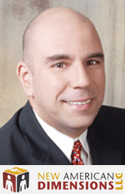5 Ways to Win With Social Media Strategy
 The threshold of having a successful engagement with consumers on social media is constantly on the rise. Like for most things, there is no correct way to approach this task however, it is important to keep some key principles in mind such as: having a grasp of consumer insights, being fluent in Internet culture, staying true to the brand and being tech savvy.
The threshold of having a successful engagement with consumers on social media is constantly on the rise. Like for most things, there is no correct way to approach this task however, it is important to keep some key principles in mind such as: having a grasp of consumer insights, being fluent in Internet culture, staying true to the brand and being tech savvy.


 Hispanic Americans are by far the fastest growing target audience in the U.S. Do you know how to reach them? Do you know their motivating factors and purchase habits? Or which types of content work best in connecting with this audience?
Hispanic Americans are by far the fastest growing target audience in the U.S. Do you know how to reach them? Do you know their motivating factors and purchase habits? Or which types of content work best in connecting with this audience? Marketers should require media agencies to be fully transparent to elevate trust and restore confidence in the client/agency partnership, according to a wide-ranging set of recommendations released \ by the ANA (Association of National Advertisers) and Ebiquity/FirmDecisions. A key recommendation was that clients require their agencies to disclose all potential conflicts of interest and allow thorough audits of the agency, its parent company, affiliates, and subsidiaries to ensure full transparency and contract compliance.
Marketers should require media agencies to be fully transparent to elevate trust and restore confidence in the client/agency partnership, according to a wide-ranging set of recommendations released \ by the ANA (Association of National Advertisers) and Ebiquity/FirmDecisions. A key recommendation was that clients require their agencies to disclose all potential conflicts of interest and allow thorough audits of the agency, its parent company, affiliates, and subsidiaries to ensure full transparency and contract compliance. The Council for Research Excellence (CRE) tunveiled findings from a new platform usage study that shows TV outperforming computer, smartphone and tablet in viewer ad attention and recall.
The Council for Research Excellence (CRE) tunveiled findings from a new platform usage study that shows TV outperforming computer, smartphone and tablet in viewer ad attention and recall. While digital marketing technologies and engagement channels multiply, many marketers remain concerned that they are still not delivering what customers want most: a seamless, frictionless and individualized buying and problem-solving experience.
While digital marketing technologies and engagement channels multiply, many marketers remain concerned that they are still not delivering what customers want most: a seamless, frictionless and individualized buying and problem-solving experience. My conclusion is that Cannes is an ad festival by tradition only anymore. What it has turned into is a tech-deal-makers meet, agency-deal-makers swap meet. Don’t get me wrong. Deal-making is really important. And to have a large number of buyers, sellers and middle men in one place is convenient, allowing for meeting after meeting after meeting in search of a deal. But it has very little to do anymore with celebrating great creative work.
My conclusion is that Cannes is an ad festival by tradition only anymore. What it has turned into is a tech-deal-makers meet, agency-deal-makers swap meet. Don’t get me wrong. Deal-making is really important. And to have a large number of buyers, sellers and middle men in one place is convenient, allowing for meeting after meeting after meeting in search of a deal. But it has very little to do anymore with celebrating great creative work. When I worked on my first survey with Hispanic respondents, circa 1980, the best-in-class approach to reach a fully representative sample was to go door-to-door. Of course, this was pre-cellphones, pre-internet and when Hispanic landline telephone penetration was around 70 percent. The market was growing and evolving rapidly (and still is, but in different ways). By the later part of the 80s we were able to complete fairly representative surveys via landline. We’ve come a long way since those early years in Hispanic marketing, and for the most part, the Hispanic consumer is as savvy and sophisticated as the general market consumer, but there are still sampling nuances to take into account. By Raul Lopez – Principle and Chief Research Officer / New American Dimensions
When I worked on my first survey with Hispanic respondents, circa 1980, the best-in-class approach to reach a fully representative sample was to go door-to-door. Of course, this was pre-cellphones, pre-internet and when Hispanic landline telephone penetration was around 70 percent. The market was growing and evolving rapidly (and still is, but in different ways). By the later part of the 80s we were able to complete fairly representative surveys via landline. We’ve come a long way since those early years in Hispanic marketing, and for the most part, the Hispanic consumer is as savvy and sophisticated as the general market consumer, but there are still sampling nuances to take into account. By Raul Lopez – Principle and Chief Research Officer / New American Dimensions This year’s events (US elections, UEFA Euro 2016 , Summer Olympics in Brazil, and Copa America in the US) will generate incremental advertising spending and thus boost media owner advertising revenues compared to 2015 (when no such events took place.) Neutralizing the impact of those cyclical events in 2015, 2016 and 2017, the global advertising market would grow by approximately +4% in both 2015 and 2016, which suggests no significant acceleration in the underlying ad demand beyond the cyclical drivers, as the economic environment remains uncertain.
This year’s events (US elections, UEFA Euro 2016 , Summer Olympics in Brazil, and Copa America in the US) will generate incremental advertising spending and thus boost media owner advertising revenues compared to 2015 (when no such events took place.) Neutralizing the impact of those cyclical events in 2015, 2016 and 2017, the global advertising market would grow by approximately +4% in both 2015 and 2016, which suggests no significant acceleration in the underlying ad demand beyond the cyclical drivers, as the economic environment remains uncertain. It’s been about a week since the ANA’s report into transparency hit the best seller lists. Lest we forget (and judging from some of the less temperate comments flying around some seem to have forgotten) the report was titled “An Independent Study of Media Transparency in the U.S. Advertising Industry.” It was not titled “Why Advertisers Hate the Holding Companies” nor “We Name the Guilty Parties.” By Brian Jacobs The Cog Blog
It’s been about a week since the ANA’s report into transparency hit the best seller lists. Lest we forget (and judging from some of the less temperate comments flying around some seem to have forgotten) the report was titled “An Independent Study of Media Transparency in the U.S. Advertising Industry.” It was not titled “Why Advertisers Hate the Holding Companies” nor “We Name the Guilty Parties.” By Brian Jacobs The Cog Blog The ANA released a K2 report on media buying practices. Although the 4A’s has worked collaboratively with the ANA via a joint task force, this report is anonymous, one-sided and paints the entire industry with the same negative brush. This statement further elaborates the 4A’s position on this issue.
The ANA released a K2 report on media buying practices. Although the 4A’s has worked collaboratively with the ANA via a joint task force, this report is anonymous, one-sided and paints the entire industry with the same negative brush. This statement further elaborates the 4A’s position on this issue. The first of two ANA reports has landed, containing the results of 150 interviews conducted by the investigators K2 with ‘marketers, media suppliers, ad tech vendors, current and former advertising and media agency professionals, trade association executives, industry consultants, attorneys, barter company employees, and post-production professionals’. By Brian Jacobs / Brian Jacobs & Associates
The first of two ANA reports has landed, containing the results of 150 interviews conducted by the investigators K2 with ‘marketers, media suppliers, ad tech vendors, current and former advertising and media agency professionals, trade association executives, industry consultants, attorneys, barter company employees, and post-production professionals’. By Brian Jacobs / Brian Jacobs & Associates
























